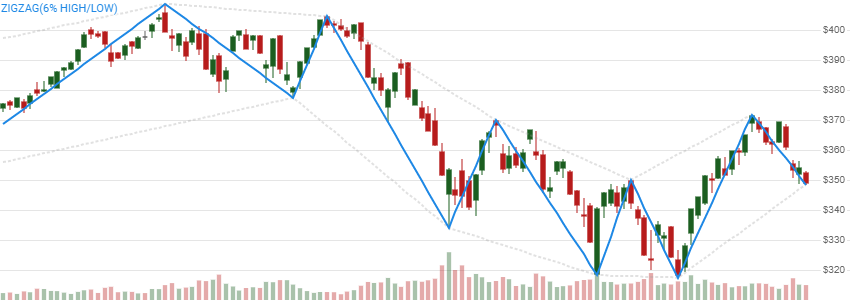Zig Zag
get_zig_zag(quotes, end_type=EndType.CLOSE, percent_change=5)
Parameters
| name | type | notes |
|---|---|---|
quotes | Iterable[Quote] | Iterable of the Quote class or its sub-class. • See here for usage with pandas.DataFrame |
end_type | EndType, default EndType.CLOSE | Determines whether close or high/low are used to measure percent change. See EndType options below. |
percent_change | float, default 5 | Percent change required to establish a line endpoint. Example: 3.5% would be entered as 3.5 (not 0.035). Must be greater than 0. Typical values range from 3 to 10. |
Historical quotes requirements
You must have at least two periods of quotes to cover the warmup periods, but notably more is needed to be useful.
quotes is an Iterable[Quote] collection of historical price quotes. It should have a consistent frequency (day, hour, minute, etc). See the Guide for more information.
EndType options
from stock_indicators.indicators.common.enums import EndType
| type | description |
|---|---|
EndType.CLOSE | Percent change measured from close price (default) |
EndType.HIGH_LOW | Percent change measured from high and low price |
Returns
ZigZagResults[ZigZagResult]
- This method returns a time series of all available indicator values for the
quotesprovided. ZigZagResultsis just a list ofZigZagResult.- It always returns the same number of elements as there are in the historical quotes.
- It does not return a single incremental indicator value.
- If you do not supply enough points to cover the percent change, there will be no Zig Zag points or lines.
- The first line segment starts after the first confirmed point; ZigZag values before the first confirmed point will be
None. - The last line segment is an approximation as the direction is indeterminate.
🚩 Warning: depending on the specified
endType, the indicator cannot be initialized if the firstQuoteinquoteshas aHigh,Low, orClosevalue of 0 (zero).👉 Repaint warning: the last line segment will always be redrawn back to the last known pivot. Do not attempt to calculate incremental values since previous values may change based on newer quotes.
ZigZagResult
| name | type | notes |
|---|---|---|
date | datetime | Date |
zig_zag | Decimal, Optional | Zig Zag line for percent_change |
point_type | str, Optional | Zig Zag endpoint type (H for high point, L for low point) |
retrace_high | Decimal, Optional | Retrace line for high points |
retrace_low | Decimal, Optional | Retrace line for low points |
Utilities
See Utilities and Helpers for more information.
Example
from stock_indicators import indicators
from stock_indicators import EndType # Short path, version >= 0.8.1
# This method is NOT a part of the library.
quotes = get_historical_quotes("SPY")
# Calculate 3% change ZIGZAG
results = indicators.get_zig_zag(quotes, EndType.CLOSE, 3);
About Zig Zag
Zig Zag is a price chart overlay that simplifies the up and down movements and transitions based on a percent change smoothing threshold. [Discuss] 💬
